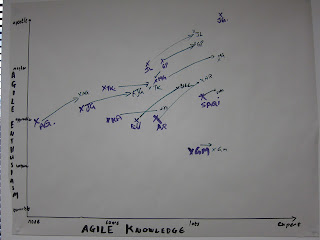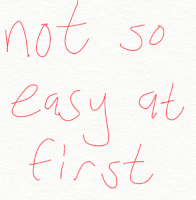Caveats:
Some people reject/debunk NLP (Neural Linguistic Programming) in its entirety. I find some of it useful to know and to teach to others. I do this by skipping the whole NLP thing and just honing in on the particular tools where relevant - for example below.
Required:
A bit of time to chat through various situations
Step 1:
According to NLP: the New Technology of Achievement humans are motivated in 2 ways:
- TOWARD what we want
- AWAY from what we don't want
For instance:
- Going to pat the friendly happy dog
- Keeping distance/getting away from the angry aggressive dog growling and barking madly
Another way to think about these motivational directions:
- Toward oriented people are goal-directed (outcome focussed)
- Away oriented people are more interested in identifying and solving problems (journey focussed)
Step 2:
Of course, as is clear in the example, humans use both motivation directions depending on a variety of factors - eg environmental, experience, etc.
However, we also, due to the wiring of our brains according to the NLP model, tend to specialise in 1 direction of motivation more than the other, and hence use it in situations where really the other motivation direction is better. And this is where I find many people in coaching situations trying to make changes happen for themselves or for their teams, but just not succeeding.
Step 3:
Armed with the knowledge of motivation direction, we take a look at the goals and rethink what motivation direction is more in play. We do the usual things of listing the pros and cons of making the change...but it is still not enough.
Step 4:
Making use of another tool from NLP, I ask the coachee to describe the image of achieving each of the goals.
Goals that are not so important to the coachee, or are "away from" motivationally oriented are usually described in 2 dimensions, little or no movement, little or no colour, with some distance between the goal description and the coachee describing it - the coachee is an observer.
Goals that are important to the coachee, or are "towards" motivationally oriented are usually described in great deal more richly: 3 dimensions, sound, colour, movement, passion, excitement - it is clear the coachee is engaged in achieving the change. The coachee is part of the scenario.
Step 5:
Now that the list of goals, and the motivational orientation of each has been analysed, there is 1 more tool that NLP provides that helps people perform a change they do not really want to: The New Behaviour Generator.
New Behaviour Step 1: Preparation
Ask the coachee to focus on themselves, to settle in, find quietness and relax. Ask them to imagine another "them" who they are observing.
New Behaviour Step 2: Choose the goal / task required to fulfil the goal
Ask the coachee to select the task which is currently blocking the fulfilment of the goal.
New Behaviour Step 3: Imagine the benefits
Ask the coachee to imagine their imaginary clone reaping the rewards of performing the task.
New Behaviour Step 4: Imagine the clone performing the task, completing the task, and achieving the benefits
Ask the coachee to imagine their imaginary clone performing the task - going through the troubles, the problems, the challenges, and overcoming each one, all the while becoming more confident and beginning to enjoy the benefits of fulfilling the task / goal. And finally when the goal is achieved, observing how the imaginary clone is enjoying all the benefits and sense of satisfaction that is evident.
New Behaviour Step 5: Integration
Ask the coachee to imagine that the imaginary clone now merges with themself in the observer position. Some people hug to initiate the merging. Some people feel a surge of energy or tingling when this integration occurs.
New Behaviour Step 6: Planning
Now ask the coachee when they will perform the task for real, and followup!
Step 6:
Repeat for each of "away from" goals. I prefer to do this exercise only once per session as the amount of energy required from the coachee can in some instances be great.
These NLP tools do sometimes take a bit of practice to master. The key is "baby steps" and checkpoints full of feedback along the way. The key metric is the quantity and the richness of the description of the description the coachee provides. As coach you can suggest adding music to the scenario if it is missing, to enhance the colours or the movement etc etc to really help manifest the future desirable state. Some of my coachees have also benefited themselves by reading Rhonda Byrne's The Secret .
Some people reject/debunk NLP (Neural Linguistic Programming) in its entirety. I find some of it useful to know and to teach to others. I do this by skipping the whole NLP thing and just honing in on the particular tools where relevant - for example below.
Required:
A bit of time to chat through various situations
Step 1:
According to NLP: the New Technology of Achievement humans are motivated in 2 ways:
- TOWARD what we want
- AWAY from what we don't want
For instance:
- Going to pat the friendly happy dog
- Keeping distance/getting away from the angry aggressive dog growling and barking madly
Another way to think about these motivational directions:
- Toward oriented people are goal-directed (outcome focussed)
- Away oriented people are more interested in identifying and solving problems (journey focussed)
Step 2:
Of course, as is clear in the example, humans use both motivation directions depending on a variety of factors - eg environmental, experience, etc.
However, we also, due to the wiring of our brains according to the NLP model, tend to specialise in 1 direction of motivation more than the other, and hence use it in situations where really the other motivation direction is better. And this is where I find many people in coaching situations trying to make changes happen for themselves or for their teams, but just not succeeding.
Step 3:
Armed with the knowledge of motivation direction, we take a look at the goals and rethink what motivation direction is more in play. We do the usual things of listing the pros and cons of making the change...but it is still not enough.
Step 4:
Making use of another tool from NLP, I ask the coachee to describe the image of achieving each of the goals.
Goals that are not so important to the coachee, or are "away from" motivationally oriented are usually described in 2 dimensions, little or no movement, little or no colour, with some distance between the goal description and the coachee describing it - the coachee is an observer.
Goals that are important to the coachee, or are "towards" motivationally oriented are usually described in great deal more richly: 3 dimensions, sound, colour, movement, passion, excitement - it is clear the coachee is engaged in achieving the change. The coachee is part of the scenario.
Step 5:
Now that the list of goals, and the motivational orientation of each has been analysed, there is 1 more tool that NLP provides that helps people perform a change they do not really want to: The New Behaviour Generator.
New Behaviour Step 1: Preparation
Ask the coachee to focus on themselves, to settle in, find quietness and relax. Ask them to imagine another "them" who they are observing.
New Behaviour Step 2: Choose the goal / task required to fulfil the goal
Ask the coachee to select the task which is currently blocking the fulfilment of the goal.
New Behaviour Step 3: Imagine the benefits
Ask the coachee to imagine their imaginary clone reaping the rewards of performing the task.
New Behaviour Step 4: Imagine the clone performing the task, completing the task, and achieving the benefits
Ask the coachee to imagine their imaginary clone performing the task - going through the troubles, the problems, the challenges, and overcoming each one, all the while becoming more confident and beginning to enjoy the benefits of fulfilling the task / goal. And finally when the goal is achieved, observing how the imaginary clone is enjoying all the benefits and sense of satisfaction that is evident.
New Behaviour Step 5: Integration
Ask the coachee to imagine that the imaginary clone now merges with themself in the observer position. Some people hug to initiate the merging. Some people feel a surge of energy or tingling when this integration occurs.
New Behaviour Step 6: Planning
Now ask the coachee when they will perform the task for real, and followup!
Step 6:
Repeat for each of "away from" goals. I prefer to do this exercise only once per session as the amount of energy required from the coachee can in some instances be great.
These NLP tools do sometimes take a bit of practice to master. The key is "baby steps" and checkpoints full of feedback along the way. The key metric is the quantity and the richness of the description of the description the coachee provides. As coach you can suggest adding music to the scenario if it is missing, to enhance the colours or the movement etc etc to really help manifest the future desirable state. Some of my coachees have also benefited themselves by reading Rhonda Byrne's The Secret .


.JPG)
.JPG)














![Merrill Covey Matrix (By Rorybowman (Own work) [Public domain], via Wikimedia Commons) Covey Matrix](https://upload.wikimedia.org/wikipedia/commons/3/32/MerrillCoveyMatrix.png)






